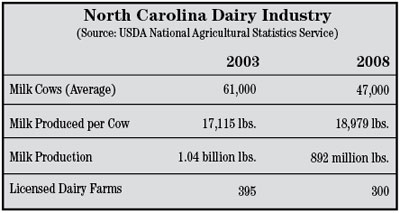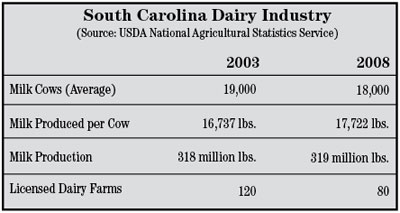 |
|||

|
 |

|
|
State of the Industry
South Atlantic states look to new pastures for dairy growth
Editor’s note: As part of our “State of the Industry” series we take a look at the cheese and dairy industry across the United States. Each month we examine a different state or region, looking at key facts and evaluating areas of growth, challenges and recent innovations. This month we are pleased to introduce our latest states — Georgia, North Carolina and South Carolina.
By Rena Archwamety
MADISON, Wis. — The dairy industries in Georgia, North Carolina and South Carolina tackle challenges similar to those found in other areas in the east and across the country. Expanding urban centers have driven up the price of farmland, dairy farmers are reaching retirement age with no one to take over the farm, and volatile pricing has made stability and profitability difficult to achieve.
 © 2009 Johnston Family Farms |
| FRIENDLY PASTURES — A young visitor greets one of the dairy cows at Johnston Family Farms in Newborn, Ga. The family-owned farm milks 80-100 cows a day and lets the herd graze as much as possible. Pasture grazing has become increasingly popular in South Atlantic states, where the climate is ideal for growing forages year-round. |
The falling economy has made things worse, but Williams says for the past 10-15 years the Southeast also has been in a vicious cycle of declining milk supply that triggers increasing costs to import milk from out of state. It gets worse every year when the price drops, more dairy farms go out of business, and the next year the state has to import even more milk, he says.
Between 1998 and 2008, Georgia lost 17,000 milk cows, and its annual milk production dropped by 82 million pounds, according to USDA’s National Agricultural Statistics Service. North Carolina lost 28,000 or almost 40 percent of its milk cows, and its annual milk production dropped by 359 million pounds in the last decade. South Carolina has stabilized in the last several years but still lost 7,000 milk cows and 55 million pounds of annual milk production since 1998.
“The whole Southeast, we’re seriously deficit,” says Geoff Benson, an extension dairy specialist at North Carolina State University. “We don’t even produce half the fluid milk we drink.”
Despite the decline in numbers, the dairy industries in these states say there is potential to stabilize and possibly reverse that trend through new opportunities.
“The Southeast is milk deficit, but we’re trying to change that,” says Farrah Newberry, executive director, Georgia Milk Producers Inc. “The people are here, so it doesn’t make sense that we couldn’t have support here. We’re working on different things to reverse that.”
The three states recently have implemented programs or research in areas such as infrastructure and support, tax incentives, and pasture grazing and relocation, all aimed at improving the stability of their dairy industries.
• North Carolina

In North Carolina, dairy industry representatives from producers and processors to businesses to government and university organizations joined to launch a program last year called “Dairy Advantage.” Still in its implementation stage, Dairy Advantage aims to enhance the value of milk and dairy products, enhance the quality of life for dairy farm families, increase milk production volume and support dairy farm numbers in the state.
The committee recently hired a dairy development coordinator from Wisconsin, Matthew Lange, who started work in January and will work full time to help develop programs to retain farms and relocate others from urban areas.
Currently most of North Carolina’s dairies are located in the central part of the state, but that also is where towns are growing and there is more urban pressure.
“We’re a rapidly growing state from a population standpoint, with more than 9 million people in North Carolina,” Benson says.
Benson says Dairy Advantage is eyeing the eastern part of the state, which is less populated and has some good farmland that is not too expensive, as a place to recruit or relocate dairies.
“In the 1950s, there was an effort to recruit dairies into North Carolina. There were people who dairied in eastern North Carolina, a row crop area, where they grow soybeans, wheat and tobacco,” Benson says. “We’re trying to develop contacts and put together an evaluation, so if a new dairy came in we could tell them what resources we could offer.”
• Georgia

Georgia, which has seen 40 percent of its dairies and most of its small dairy farms disappear over the last decade, has been encouraged by an influx of new pasture-grazed dairy herds moving into the state.
“We do have kind of a bright spot in Georgia,” Newberry says. “During the last few years, a group of New Zealand farmers have moved in for the grazing land. There are close to seven dairies, with a goal of 25.”
The New Zealand grazing dairies are located in the eastern and central parts of the state, close to Augusta, the coast and the South Carolina border.
“They studied the entire United States and found that this area mirrored what they had in New Zealand as far as climate and growing season,” Newberry says.
She adds that the state probably has had an additional 5-10 dairy farms switch to grazing dairies in the last several years, and since the New Zealand dairies arrived, the University of Georgia has done more research on forages and maintaining pastures for dairy herds.
“More research will be available soon, which will help all of us,” Newberry says.
Benson says North Carolina also has considered and is researching the possibility of more pasture-based dairies.
“We can grow something most times of the year,” Benson says. “It’s not New Zealand, but we can grow forages in the winter. We’re looking at all the possibilities.”
In addition to its research on forages, the University of Georgia is working to rebuild some of the state’s lost infrastructure by offering a guaranteed scholarship to veterinary school for those who plan to work as large animal veterinarians in the state.
Georgia is working to recruit more dairies as well, and Georgia Milk Producers Inc. has a Georgia dairy promotion team that has been at the World Dairy Expo and several farm shows to give the state more exposure.
“We want to grow the industry, focus on grazing and attract dairy farmers to Georgia,” Newberry says. “We support research for new, innovative ways to dairy in Georgia. The milk marketing order tells us that in 10 years we won’t have dairies in Georgia, and that scares us to death.”
• South Carolina

South Carolina has seen its dairy industry start to dwindle over the past decade as well, dropping to only 80 dairy farms and half the cows it had just five years earlier.
“Historically we produced 80 percent of our milk and shipped in 20 percent. Now that’s reversed and we ship in 80 percent, with the good portion from Texas and the Midwest,” says Kelly Smith, secretary and executive director, South Carolina Dairy Association, adding that with the decline in cows and dairy farms, a reduction in dairy processing plants followed.
One thing that has helped slow the decline of South Carolina’s dairy industry is a dairy tax credit program, passed about three years ago. If a farmer’s price falls below a certain level, based on milk prices in various metropolitan areas, the credit kicks in to prevent too much loss.
“It’s been very effective to stabilize the industry,” Smith says, adding that it’s the state’s strongest incentive to recruit and maintain dairy farms. “We have a government that’s very favorable to the industry with the tax credit program. We’re one of the few states that has that program.”
• Dairy processing in the South
Some bright spots also have emerged for these states on the dairy products side. In addition to major co-ops and processors in the region such as Dairy Farmers of America, Maryland & Virginia Milk Producers, Southeast Milk and Dean Foods, there has been increased interest and support for niche dairy products such as artisan cheese and farm bottled milk.
South Carolina’s Department of Agriculture has a program that promotes state-made products, including dairy products. Since 2004, North Carolina State University has hosted a farmstead cheesemaking short course. Goat dairies and dairy products also recently have increased in the South Atlantic region.
“We do have an increasing interest in artisan and homestead cheesemaking,” Benson says, adding that North Carolina currently has about 18 goat cheesemakers, including one, Holly Grove Goat Dairy in Mt. Olive, N.C., with 700 goats.
The Southern Cheesemakers’ Guild includes artisan cheesemakers from all three states along with several other South and Southeast cheesemakers.
“I think we will see the niche marketing of dairy products, cheese, milk, those things,” Smith says of South Carolina’s dairy future. “We are seeing a lot of goat products in this state, and cheese, and we would like to see more.”
Smith says South Carolina’s dairy industry is facing the same problems that a lot of states have, such as fuel prices, land and taxes, but he would like to see it become more active with more dairy farms.
Benson says he has seen more optimism in the dairy industry since North Carolina’s Dairy Advantage program has launched.
“There’s some activity — it may be small, but we’re trying to be energetic,” he says. “I think people’s morale is better. It’s tough everywhere, but not hopeless. People trying to do something helps people’s attitude.”
CMN
| CMN article search |
|
|
© 2024 Cheese Market News • Quarne Publishing, LLC • Legal Information • Online Privacy Policy • Terms and Conditions
Cheese Market News • Business/Advertising Office: P.O. Box 628254 • Middleton, WI 53562 • 608/831-6002
Cheese Market News • Editorial Office: 5315 Wall Street, Suite 100 • Madison, WI 53718 • 608/288-9090